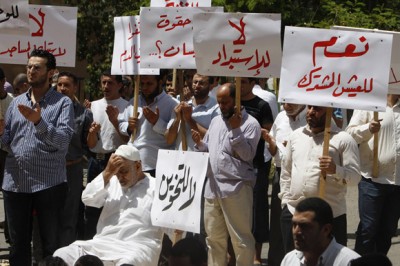Demonstrations spread to numerous Syrian cities Friday, with thousands braving a security crackdown in what protesters dubbed a “day of defiance” against President Bashar Assad’s government, according to witnesses and videos posted online.

Protesters claimed that their movement had expanded to all of the country’s major cities from Dara in the south, where the uprising began more than six weeks ago. They reported protests in various neighborhoods of the capital, Damascus, and its suburbs, the northern cities of Aleppo and Latakia, Homs and Hama in the west, the coastal city of Baniyas, and smaller towns and villages.
Citing human rights activists, news services reported that at least 30 people were killed Friday during the protests. However, activists could only confirm the names of three of the dead to The Times.
The toll appeared lower than a week earlier, when reportedly scores of protesters were killed during demonstrations.
On Friday, videos showed protesters flooding the streets of Homs, chanting “God is great!” and “The people want to overthrow the regime!” In a video from Damascus, demonstrators appeared to be fleeing gunfire as they called for the overthrow of Assad, singing “Millions of martyrs are going to heaven.”
Homs, the country’s third-largest city, saw some of the largest protests, according to a resident who asked not to be identified. “People are growing less fearful and more insistent,” the man said when reached by telephone.
As gunfire sounded in the background, he said that at least 10,000 protesters had assembled in the city, including some as young as 16, demanding Assad’s ouster.
“This is it,” he said. “We all want the regime to end. It is unanimous.”
Al Jazeera satellite television showed video of tanks on the streets of Homs, and protesters tweeted that heavy machine-gun fire could be heard in the Asherah, Alseten and Alzahraa areas of the city. Earlier in the day, Syrian troops had stormed Homs University, according to the Al Arabiya network.
In Baniyas, Al Jazeera showed protesters chanting their solidarity with demonstrators in Dara.
“The government is saying we have weapons. I swear we don’t have weapons; our weapons are only our phones and cameras,” said a protester in Baniyas who asked not to be identified for fear of being arrested.
Wissam Tarif, executive director of the Syrian human rights group Insan, said security forces shot at protesters on the outskirts of Damascus and that there were government snipers in suburban Saqba and nearby Zabadani, where protesters said at least 300 people were arrested.
“They have been made clearly visible to instill fear,” he said.
Tarif said the army had set up checkpoints at the entrances to several cities. “Security forces and the army have prevented protesters from entering main squares and are limiting demonstrations in various neighborhoods,” he said.
Protesters reported that more than 7,000 people had gathered in Damascus and surrounding areas. At least one demonstrator was hospitalized in the capital after being shot by security forces, Tarif said. He added that many others also had been hospitalized in the capital, although that information could not be verified.
Syria’s Interior Ministry had warned people to stay home Friday as troops were deployed around the country. State television reported that a soldier and four police officers were shot and killed by “criminal gangs” in Homs, but the report could not be verified.
Since March 15, at least 542 people have been killed by security forces, according to Amnesty International.
European Union governments agreed Friday to freeze the assets of and impose travel restrictions on 13 Syrian officials held responsible for the crackdown, an alliance official told the Associated Press. Assad was not included.
Last week, EU member states agreed to impose an arms embargo on Syria. All the measures are expected to be formally approved early next week, the official said. LAT
Leave a Reply
You must be logged in to post a comment.